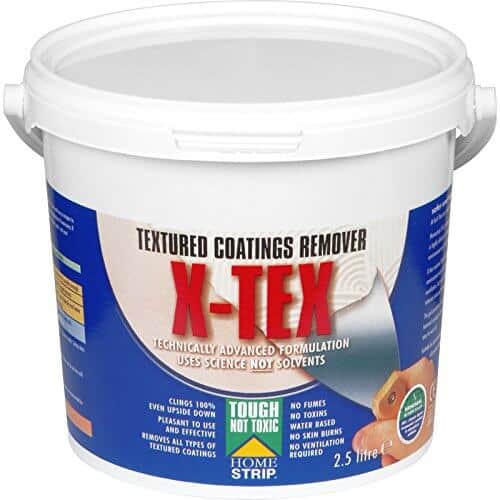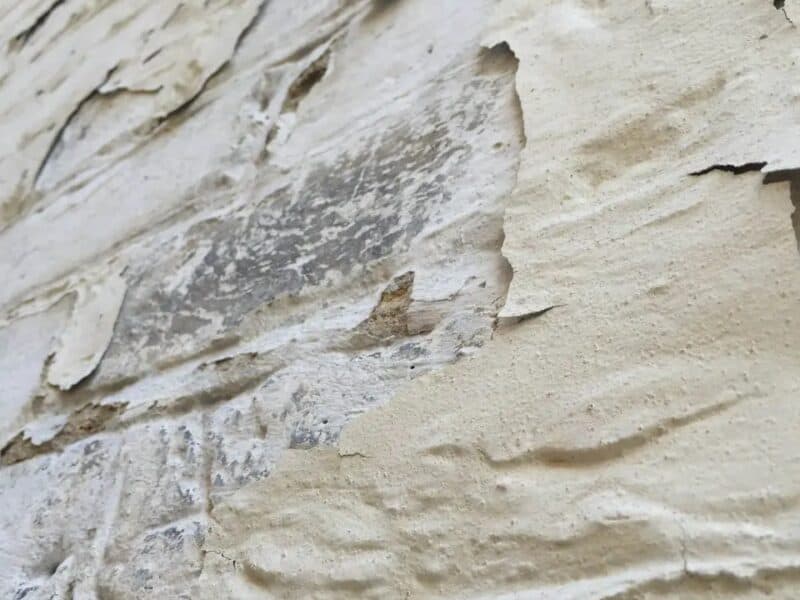One of the most frequently asked questions about interior decorating is how to remove or cover-over textured coatings – commonly referred to as artex.
Not only was this kind of finish quite fashionable in the late 1970’s and early 1980’s but it now seems to becoming common practice for house builders to finish new ceilings with a form of textured coating because it is more economical and expedient than traditional plaster finishes.
It also covers a multitude of defects! So the problem is not confined to just older properties.
Does Artex Contain Asbestos?
Asbestos was used extensively as a building material from the 1950s through to the mid 1980s. Any building built before 2000 can contain asbestos.
Asbestos materials in good condition are safe unless the fibres become airborne when materials are damaged – which is why you should never use an industrial sander to remove textured coatings.
Some textured coatings (not just Artex) did contain an amount of white (Chrysotile) asbestos and, despite what you may read elsewhere, the official advice from the Health and Safety Executive is that this is just as hazardous to health as any other form of asbestos.
Best Ways to Remove a Textured Coating
The only practical way to remove textured coatings is with the use of a steam stripper and an awful lot of elbow grease. It is very likely that the finish will have been painted over at some point which makes it all the more difficult to remove.
Scoring or perforating the surface to allow the steam to penetrate will certainly help but whatever you do this is going to be hard work and not a job you’ll complete in an afternoon.
There are products available which claim to make the process easier but, not having used any of these myself, I can’t vouch for their effectiveness.

Available from amazon.co.uk
Furthermore, if the wall or ceiling underneath is in a poor state – or, in the case of a new property, just a plasterboard surface, it is likely that there will a lot of repair work to be done once all the textured finish is removed.
The simplest way to deal with this problem is often to plaster over the surface altogether. Firstly by removing any obvious high-spots (or lumps) with a scraper and then applying a bonding agent, such as PVA, to the surface.
Once this has dried you’ll be able to plaster over the surface with a coat of multi-finish plaster which will result in a perfectly smooth and flat wall or ceiling finish which you can decorate as you wish.
Comments
How do you know if artic has got asbestos in it? READ MORE…
Alan Bird – A qualified surveyor will send a sample of the material to an independent laboratory for testing! This is easily done, quick and quite cheap, £25 for first sample, then £12.50 for additional ones, but definitive.
There is a lab at ThamesLabs, Hollow Farm, 9 Hilton Rd. Fenstanton, Cambs. see http://www.thameslabs.co.uk; tel: 01480 891800. They produce a certificate to accompany their analysis.
A friend used this service, recently to check a wood-block flooring sample from a reclaimed materials specialist because the adhesive is bitumen-based and often had asbestos in it. The test was negative and so her new flooring material is safe to re-deploy! Cheap reassurance…
Alan Bird MRICS (Chartered Surveyor)
Definitely worth having a test done for asbestos if any work on your artex is likely to generate dust. I called in an asbestos company to test some dry wall I was already sure was asbestos. READ MORE…
The plasterers were taking the bumps off the artex on the downstairs ceilings – none of us knew it was a potential risk. We stopped all work, took a sample from each room (they could have been done at different times) and luckily the artex all came up negative.
If you are unlucky enough to have asbstesos in artex I would either leave it alone or shop around for a specialist to remove it. The company that did the testing quoted me £3k to remove two walls of white asbstesos sheet.
I thought that was excessive for one days work and were relying on the ‘fear factor’. I found another company, used by local authority, at £1300. They turned up with all the gear and included an independent air test at the end.
At the other end of the scale I got a quote for £500 for the same work, and just had the feeling it the sheets might end up getting dumped in a back street somewhere. Matt B


